A summer tree emergency

Tree trimmer Mike Soole, campus services, drags a tree limb to a chopper outside of the Hub during cleanup on July 24. Photos by Christopher Gannon.
Campus services' tree-trimming team got an emergency assignment July 23 when half of the mature Siberian elm tree at the southwest corner of the Hub fell, much of it landing on the building. The team first removed all branches from the Hub roof and surrounding lawn and then set about removing what remained of the elm. Just the stump of the 100+ year-old tree remains to be removed.
After a temporary closure, ISU Dining was able to reopen its Hub venues Thursday morning, July 25.
A structural assessment of the Hub showed only cosmetic damage to the roof. Facilities planning and management's construction management unit currently is seeking bids for those repairs. Dependent on the successful bid company, the goal is to complete repairs before fall classes begin on Aug. 26.
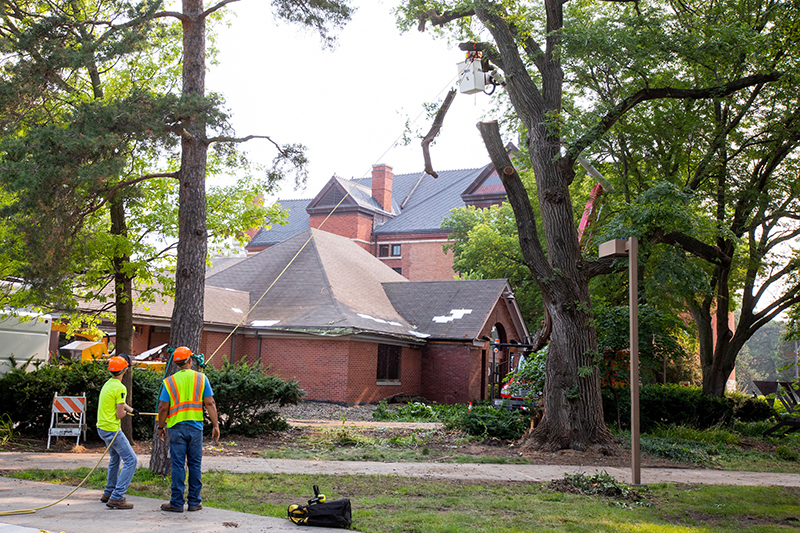
Campus services' tree trimming team lowers a limb section to the ground outside the Hub.
Welcome
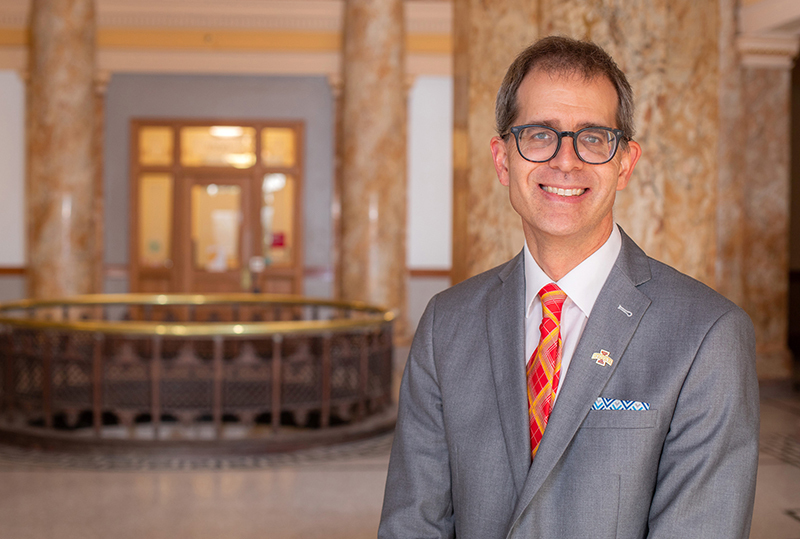
Photo by Christopher Gannon.
Jason Keith is officially on the job today (Aug. 1) as the university's senior vice president and provost.
He comes to Iowa State from another land grant, Mississippi State University, Starkville, where he was a faculty member and administrator for 13 years. He served as dean of its College of Engineering (2014-24), director of the School of Chemical Engineering (2011-14) and director of its Energy Institute (2013-14).
Under his leadership, the Engineering college developed undergraduate programs in petroleum engineering, biomedical engineering, artificial intelligence and cyber security and a nine-semester, double-bachelor degree program in industrial engineering/business administration.
Keith began his academic career as a member of the chemical engineering faculty at Michigan Tech University, Houghton (2000-11).
As Iowa State's chief academic officer, Keith oversees:
- Seven academic colleges
- Graduate College
- University Library
- Enrollment management
- Office of the vice president for research
- Office of the vice president for extension and outreach
The director of the U.S. Department of Energy's Ames National Laboratory on the north side of campus also reports to the provost.
Keith earned two degrees in chemical engineering, a bachelor's degree from The University of Akron, Ohio, and a doctoral degree from the University of Notre Dame, Indiana.
Keith's office is in 1550 Beardshear. He can be reached by phone at 515-294-0070, via email at jkeith@iastate.edu.
A winning combo for recycling
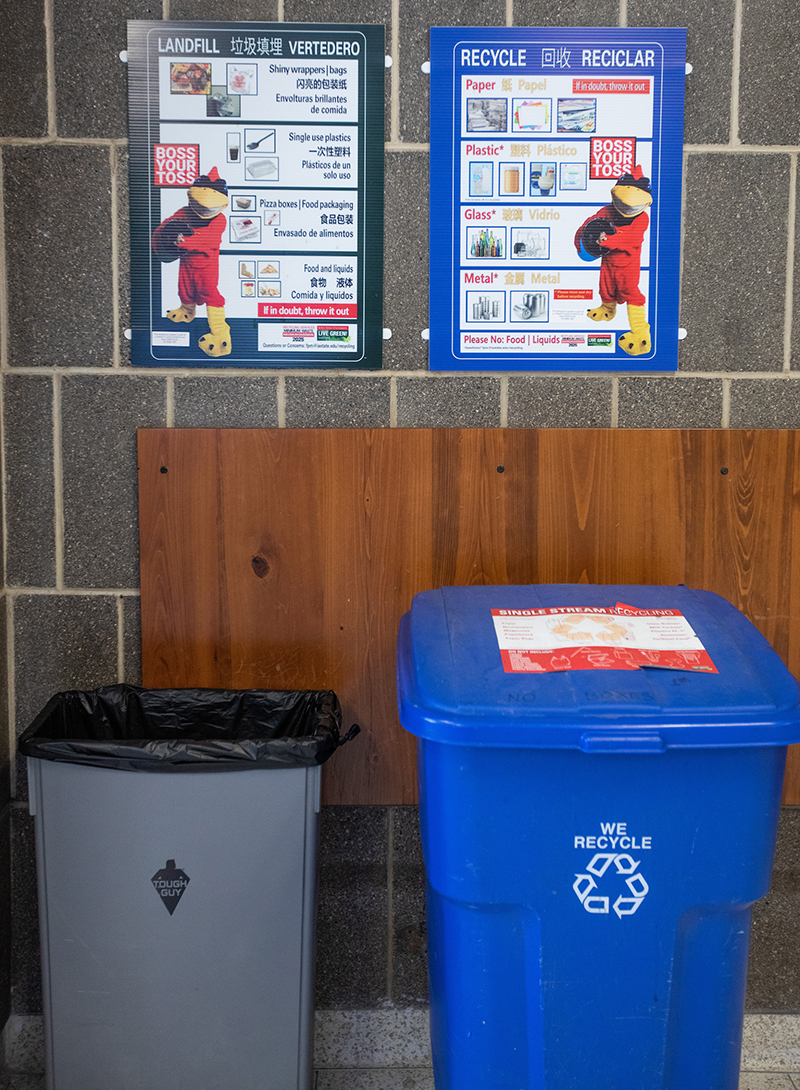
A waste system in Carver Hall -- two bins and two posters -- clarifies items for recycling and items that need to be treated as trash. Photo by Christopher Gannon.
By the start of fall classes, recycling coordinator Steve Kohtz hopes to make recycling in campus buildings easier -- and more successful. Since arriving in the facilities planning and management role two years ago, his focus has been on smart, efficient recycling, which relies on separating clean recyclables from dirty or contaminated ones.
He recently wrapped up a nine-month study that tested how effectively different styles of informational posters nudge people to recycle correctly. Working with building supervisors, he'll use the results to set up "waste systems," which pair recycling and waste bins side by side and label each with pictures and words in three languages, English, Mandarin and Spanish. By the end of the month, every floor of every academic building should have a waste system: a brown or black trash bin, accompanied by a black-framed instructional poster, and a blue recycling bin, identified by a blue-framed poster.
His study during the 2023-24 academic year divided central campus buildings into three zones. The east third of campus was the control group with no changes made to indoor trash and recycling containers. He added words-only instructions in buildings on the west side and color-consistent instructional posters with words and images about what can and can't be recycled in the middle of campus.
Parks Library is an example of clients and employees making the most of the picture posters. In week 1, Kohtz said nearly 70% of recycling bin content couldn't be recycled because it was contaminated. By week 3 -- and for the duration of the study -- that fell to less than 20%.
"I want to congratulate the Iowa State community for a job well done," Kohtz said. "During those nine months, recycling actually improved in all three zones. As a university, we recycled 40 tons (36%) more than we did the previous year -- roughly the weight of a loaded 18-wheeler semitruck."
What excites Kohtz is that those 40 tons represent a growing understanding of how to recycle among employees and students. He also learned a few critical lessons. Where a stand-alone recycling bin is offered, people are likely to opt for convenience and toss in whatever they have, regardless of its potential for recycling. But offer two bins, color-code the bins and their accompanying instructions, and people are much more likely to be successful recyclers, he said.
'When in doubt, leave it out'
The most frequent offenders of contamination? Not-quite-empty coffee cups and water bottles, according to Kohtz. That's right, a half inch of water in a bottle can alter the recyclability of the contents of a bin.
In its Strategic Plan for Sustainability in Operations (2021-25), a university goal is to divert 85% of the waste it generates from a landfill or incinerator. In 2022, ISU produced nearly 4,284 tons of waste, 48% of which was diverted. Today 72% is diverted, and a focus during the coming year will be effective recycling to reach the goal.
"That's another campus accomplishment to celebrate," Kohtz said. "We have a little way to go."
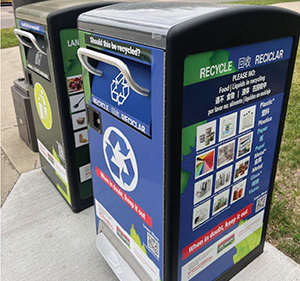
An outdoor waste system: waste (black) and recycling (blue) solar compactors. Submitted photo.
Outdoor stations
While outdoor trash and recycling containers weren't part of this study, Kohtz said he also hopes to pair newly labeled waste and recycling solar compactors at seven campus CyRide bus stops in time for fall semester.
"The goal is a campus that's unified in a visual way for recycling," he said. "That consistency should help new and long-time recyclers know what to do."
Kohtz received a $9,000 grant from the Iowa Department of Natural Resources for his study. It covered printing costs for the two color-coded posters created for the study, with funds remaining for all the additional posters needed.
Long provides 'point' leadership to disaster response

Courtney Long was named the Extension Disaster Education Network leader in July. Photo by Christopher Gannon.
Whether it is a major flood or a devastating drought, Iowans are dealing with a range of extreme and devastating events more often. ISU Extension and Outreach can help citizens in all 99 counties when disaster strikes by sharing innovative advancements from campus and being prepared to help local, regional and federal partners when called upon.
"Over the last five years, weather related disasters have cost the state of Iowa, on average, more than $3 billion per year," said Extension vice president Jason Henderson. "To be responsive to our communities we need that single contact because Iowa State is such a large university with many touch points. One of the biggest challenges we face is for people to know how to engage with us."
Henderson named Courtney Long the Extension Disaster Education Network (EDEN) leader in July. EDEN's mission is to reduce the impact of disasters through research-based education. Long will be a facilitator with federal agencies like the Federal Emergency Management Agency and regional groups like the Heartland Extension Disaster Education Network. She will connect them with extension experts who help on a range of issues during and after disasters.
"The network helps extension respond to disasters and shares research, resources and tools like scenario, table-top exercises to prepare communities before events happen," Long said. "Extension is an amazing space for this work because we have county and region extension staff, state specialists and campus staff who all fill different needs for communities throughout a disaster response cycle."
Extension's role
The position is not new, but Long is a point person in times of need like the severe flooding in western Iowa and a destructive tornado that leveled a portion of the town of Greenfield this summer. Henderson appointed a disaster response task force to work with Long over the next few months to determine priorities and parameters around extension disaster response.
"Disaster planning, response, mitigation and recovery is a priority for extension," said Long, who earned her master's degree and Ph.D. in sustainable agriculture from Iowa State. "When a disaster takes place, maybe we aren't the first to respond, but when the time is appropriate, extension can support in a variety of ways for communities recovering from different types of disaster. We want to improve the flow of communication in these times, and help individuals and communities know who can respond and provide expertise in the recovery."
Having representatives in 99 counties helps extension better understand needs and opportunities for the future. Extension is beginning a three- to five-year priority program initiative for adaptive and sustainable natural and built environments, which will include components of disaster response as well as long-term resilience.
The group will determine extension's role across the disaster recovery, ranging from planning and preparedness -- like scenario trainings -- recovery and mitigation efforts, and specific topic expertise in response to different impacts, including water quality and access, animal disease interventions, housing assessments, food systems development, and individual and community mental health.
"For extension, it's how we can help communities plan and be proactive," Henderson said. "The technology is changing and we can be there to help communities recognize impacts -- environmental and economic -- through research from our faculty that is emerging every day."
Serving others
Long, who manages extension's food systems unit and directs the Agricultural Marketing Resource Center, will spend the next several months identifying experts throughout extension to be resources for various disasters. She also will work with partners in Nebraska, Kansas and Missouri who make up the Heartland EDEN. Members share best practices for dealing with disasters, and those impacted often lean on others to help during recovery.
"Partners outside the crisis zone are important to have during and after a disaster because they're not feeling the impact. They can support that connection to potential resources," Long said. "I will help direct efforts with those partners and hope to continue to build relationships across our EDEN network to learn and respond effectively."
Long said assistance extends outside the Midwest. For example, ISU researchers were deployed to the Virgin Islands in recent years to aid recovery and conduct a wide range of research related to impacts to farmers from hurricanes.
Students helping peers: A record-setting collection
At move-out time every May since 2008, the department of residence (DOR) partners with United Way of Story County on a food collection drive. At locations in each residence hall and apartment community, students may donate unopened, nonperishable food items for distribution to food pantries in Ames. For example, in 2023, the donations went to the Salvation Army, Mid-Iowa Community Action and the Bethesda Food Pantry.
This spring was notable in two ways: Students donated 2,553 pounds of food -- nearly doubling last year's total -- and their donations stayed on campus. The food donated at moveout went to The SHOP (Students Helping Our Peers), the food pantry in Beyer Hall run by students for students.
"They made a huge difference in helping their fellow students with food insecurity," said Dave Garsow, coordinator of residence life and lead for the food donation moveout program. "Helping others is what it means to be a Cyclone, and everyone involved should be very proud."
Thanks in part to the DOR's donation, the United Way of Story County collected more than 20,000 pounds of food for just the second time in the spring food drive history.
"The large amount received went a long way for our pantry users," said April Lopez, food security and basic needs specialist for Student Wellness. "It's great to see how our students come together to support each other."
Fair visitors can experience Iowa State through 'Cyclone Vision'
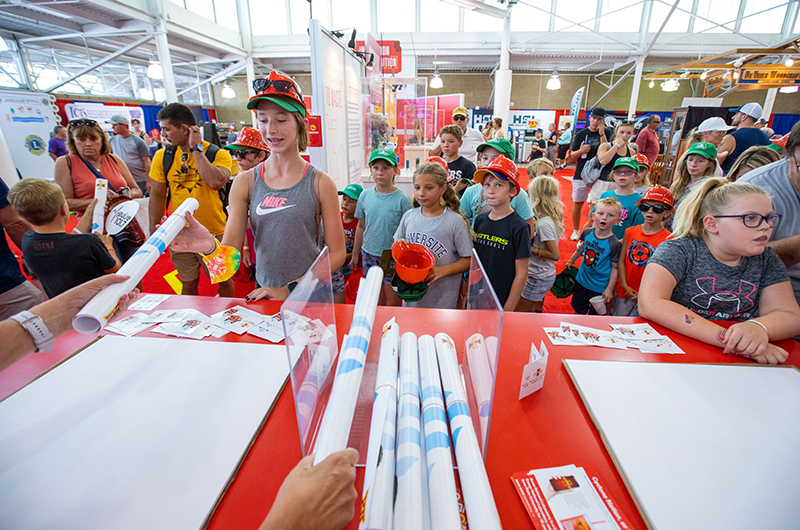
Youth queue up to receive a Cyclone football poster in the university's main exhibit at the 2022 Iowa State Fair. Archived image.
If you've ever wanted to climb to the top of the campanile for a noon concert or go inside the huddle with the Cyclone football team, you can have that experience at Iowa State University's exhibit at the this month's Iowa State Fair, Des Moines.
The "Catch the Cyclone Vision" exhibit will feature a series of 360-degree videos of unique campus experiences. In addition to the campanile and Iowa State football spring game, visitors can go behind the scenes of the Fashion Show, stroll across central campus, tour the butterfly wing at Reiman Gardens, blow glass at the Student Innovation Center with the Gaffer's Guild, go into the field with ISU researchers and cross the commencement stage at Hilton Coliseum.
"We have a beautiful campus that's nationally recognized for its outstanding landscape architecture. Visitors to the state fair will have the opportunity to experience that beauty as well as go places and see things unique to Iowa State University," said Angie Strotman, branding and marketing manager, office of strategic relations and communications.
Visitors will use their smartphone to scan the QR code that will be displayed with information about each experience. The exhibit in the Varied Industries Building is open to fairgoers from 9 a.m. to 8 p.m. every day of the fair, Aug. 8-18.
Cy, Iowa State's iconic mascot who celebrates a 70th birthday in October, will appear at the university's exhibit between 11 a.m. and 1 p.m. on Aug. 9, 10, 11, 16, 17 and 18. Visitors to the exhibit can pick up Cyclone 2024 football posters and receive free waterless temporary Cyclone tattoos. The University Book Store will offer a variety of Cyclone merchandise, gifts and apparel for sale in the exhibit. And visitors can take photos of the Big 12 championship trophies for wrestling and the men's basketball tournament, and individual trophies for NCAA champions David Carr, 165 pounds, wrestling; and Sydney Willits, long jump, indoor track and field.
4-H at the fair
Look for 4-H youth activities and displays each day in the Bruce L. Rastetter 4-H Exhibits Building. Headquartered at Iowa State and available in all 99 counties, 4-H emphasizes hands-on learning in agriculture and natural resources, leadership and civic engagement, communication and the arts, healthy living, and STEM (science, technology, engineering and mathematics).
From livestock shows to a runway fashion show to educational presentations, 4-H will host multiple activities each day of the fair. As part of STEM Day at the Fair (Aug. 18), 4-H, Iowa State's M:2:I Lab and the Iowa Space Grant Consortium will launch a high-altitude balloon around 11 a.m. on the Grand Concourse. Check out the full schedule of 4-H youth programming at the fair.
Iowa State students care for every fair animal
For more than a decade, a small and dedicated group of fourth-year veterinary students have played an integral role in animal health at the state fair. With guidance from College of Veterinary Medicine clinicians, the students examine and treat animals in need while working with owners and in view of the public.
"It gives our students the basic skills and the most variety they will see in a rotation during their fourth year," said associate clinical professor Rachel Friedrich, veterinary diagnostic and production animal medicine. "They go down the Monday before the start of the fair and are there throughout to take care of any health issues that pop up."
The number of veterinary students expanded from four to six this year as they also help collect urine samples for random drug testing, assist with the farrowing display in the Knapp Animal Learning Center and ensure proper paperwork for every animal. Fourth-year veterinary students Carly Bates, Hope Dohlman, Chelsea Harris, Adam Steffensmeier, Megan Thomas and Keith Wolverton may work with animals ranging from pigs to sea lions during the two-week rotation.
Morgan LaViolette, College of Veterinary Medicine student recruiter, will give a series of presentations at Vet Camp, an educational, hands-on learning program aimed at encouraging fourth- through seventh-graders to learn about animal health and what it's like to be an animal doctor.
Dan Grooms, the Stephen G. Juelsgaard Dean of Veterinary Medicine, will show a steer at the Governor's Charity Steer Show on Saturday, Aug. 10 (4:30 p.m., Livestock Pavilion).
